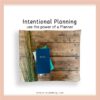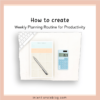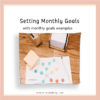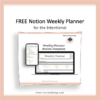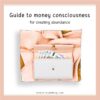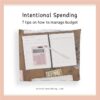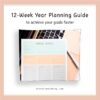Imagine starting each morning with clarity on what needs to be done.
Your daily schedule is well-set, you’ve got the most important things lined up for the day, and you’re ready to tackle them one thing at a time.
Picture effortlessly managing deadlines while still finding time for self-care and quality moments with loved ones.
Sounds great and ideal, right?
That is the magic of intentional planning.
While that scenario is not guaranteed every single day, intentional planning helps you experience this kind of ease and flow most days.
It helps you avoid the feeling of being drained by piled up responsibilities. You’ll no longer feel that you’re being pulled in different directions. Because you know what’s urgent and what can wait.
And you’ll have more focus too.
Keep reading to learn about intentional planning and discover the power of a planner.
DISCLOSURE: This post contains Affiliate Links, which means I receive commission, at no extra cost to you, when you make purchase using those affiliate links. As an Amazon Affiliate, I earn from qualifying purchases. Here’s my full Disclaimer.
After reading this post, come back here and download your Free 2-page Printable Weekly Planner or you can download it by clicking the image below.
What is intentional planning?
If life is a journey, then intentional planning is a proactive way of shaping your path. It’s a purposeful and mindful process of setting clear goals that helps you manage what you do with your time, reduces stress, and boosts productivity.
This helps you get to where you want to be with less stress and more intention.
It’s important to remember that Intentional planning isn’t a linear activity, where you start with the first step and stop at the last step. It’s a cycle and an ever-evolving practice. The cycle of intentional planning involves a continuous process of setting, executing, and refining your plans.
Here is a simplified cycle of intentional planning.
- Reflection – Taking time for introspection, and understanding your current situation. Then aligning your actions with what’s important to you.
- Setting goals- Defining clear objectives that are aligned with your aspirations and visions.
- Planning – Outlining the actionable steps to achieve your goals.
- Implementation – Putting your plans into action, making sure that your actions are according to your plan.
- Review and adjustments – Identifying areas of improvement and making necessary adjustments to stay on course.
- Celebration – Celebrating achievements and appreciating lessons learned from mistakes and challenges. This supports motivation and continued progress.
- Rinse and repeat – Embracing the cyclical nature of intentional planning, continuously refining your approach based on insights and experiences.
The role of a planner
A big part of living with intention is intentional planning.
However, intentional planning won’t be effective without a planner.
Using a planner, physical or digital, is essential because it serves as a central place for everything that you need to plan and execute. From managing what you do with your time, to planning your goals and tracking progress, a planner is the key.
Not only that, your planner is also a space for you to plan all the important events, such as birthday parties, anniversaries and holidays or travel. Your planner is the place for your appointments such as meetings, and medical appointments.
It serves as an extension of your brain so that you don’t have to mentally track all the important things in your life.
If you’re one of those business owners who’s also trying to balance family life with young children and a day job, (that’s me too), a planner is an absolute essential. And dare I say, it’s a requirement.

(Image from Lyrical Host)
How to start intentional planning
If this is your first time to try intentional planning, start with a basic plan and start small. You can also get an Intentional Week Success guide from here.
The first step is to set aside time. Then allocate specific space where you can comfortably plan without distractions.
Make sure you have tools whether it’s digital or physical.
I prefer a physical paper planner. So I have sticky notes, my favorite pens, a bullet journal, and a calendar during my planning sessions. I used to have washi tape too in my lists of things, but I don’t use it anymore. I like my bullet journal to be simple with less decoration. My old planner, a few years ago had more doodles, but now I’m just happy with lines.

When you’re ready to plan, a good starting point will be remembering your core values. This is the foundation of your plan. The next steps would be reflection time, and setting new goals (or reviewing goals, instead of setting new ones).
There’s no rule with intentional planning. Treat it as a new beginning where you can start managing everything that matters to you and do it just the way you like it.
Some people like to plan yearly, where they start by thinking about the previous year, and then plan the next year. Other people skip the yearly planning altogether and just do the monthly planning, where they look first at the entire month and go from there.
I like quarterly planning and weekly planning. I plan and review my projects every 3 months and then schedule my tasks weekly to complete those projects.
Please remember:
“Intentional planning doesn’t have to start on January 1st or at the beginning of the year. Seriously, it can start any time. The perfect time to plan is when you’re most feeling inspired and whenever you feel ready.” – intentionaleblog.com
My intentional planning framework
Through the years, my planning style has improved and evolved. At the moment, I have a very basic planning framework. I set intentions yearly, set goals quarterly, plan projects monthly, schedule tasks weekly and take action daily.
This is how it looks like.
Yearly
My husband and I set intentions for the year. This used to happen at the end of December. But when I started blogging, it got moved to September or November. Not too heavy, just casual and over coffee. Kids join when they like but they aren’t forced to do so. This is the time where we talk about travels and big plans as a family.
Quarterly
Every three months, I set and review my goals (long -term and short-term goals). Sometimes there are goals that don’t spark anymore so I let them go. And when a quarter is bit more full than normal I also let go of some goals and go back to them at a later date.
Monthly
Every month, usually on the last Monday, I plan and review my active projects. I tend to have big (projects so the monthly projects are almost always the same each month).
Weekly
Every Friday afternoon I do my Weekly Planning and Review. This is just focused on the last 7 days (and the next 7 days), so I don’t think much about the short-term and long-term goals here. It’s all about tracking progress and checking what’s working and what isn’t.
Daily
This is not really a full planning. It’s just getting ahead for the next day. Every night, before bed time, I write/update my to-do list or mentally map out the next day.

Image : Part of my Main Dashboard in Notion, where I manage my life and blog.
Finding the right planner
Ok, this part is exciting and challenging at the same time. Too many options to choose from. If you’ve been looking for the right planner and you haven’t found the one yet, please keep looking. Keep testing different planners, you’ll find the right one.
The best planner is the planner that works for you.
Here’s what you need to consider when you’re choosing the right planner.
- What’s your planning style? Do you prefer a structured and detailed planner or a more flexible one? What about space? Do you need big daily planning pages or just a small space for your daily tasks?
- Which format do you prefer? Digital or physical?
- When it comes to size and portability, do you prefer a compact pocket planner or a larger desktop planner? Are you always on the go? If so, then maybe a small or medium planner is best.
- How do you think and work? The answer to this question will help you decide what layout and design will be best for you.
- Will you need additional features like sections for goal tracking, habit tracking, or budgeting? Do you want to have stickers, or pockets of bookmarks in your planner?
It took a long time for me to find the right planner. I’ve been using Bullet Journal since 2016, and since then, I’ve never felt the need to look for another planner.
Then it got better.
In 2019, I discovered Notion – a freemium productivity and note-taking web application.
Bullet Journal combined with Notion is the best combination for me. It gives me space for productivity and mindfulness plus a bonus of staying organised.

The image above are my Bullet Journals from 2016 to 2020. I’m still using Bullet Journal now, 2023 at the time of writing this blog post. I’m sharing this because I want you to know that the best planner is the one that works for you.
Different types of Planners
If you prefer analog planner, click this link to download your free Printable Sunshine Weekly Planner
Planners come in various shapes and sizes, catering to different planning styles. Here are a few popular options:
- BULLET JOURNALS : Highly customisable and versatile planners, allowing you to create your own planning system.
- DAILY PLANNERS: Ideal for detail-oriented individuals who enjoy planning their day hour by hour.
- WEEKLY PLANNERS Perfect for those who prefer a broader overview of their week, with space for projects and habit tracking. You can either go for a Printable Planner or Digital Planner. Choose between (or have both) Free Printable Sunshine Weekly Planner or Free Notion Weekly Planner Template.
- MONTHLY PLANNERS: Suited for managing projects, allowing you to focus on your mini-goals to achieve big goals
- QUARTERLY PLANNERS: Ideal for those who prefer to break down their goals and plans into quarters, providing a balance between short-term focus and long-term vision.
- YEARLY PLANNERS: Designed for long-term planning, usually with yearly, monthly, and weekly sections
- GOAL PLANNERS: Tailored for goal-setting and tracking progress toward short-term and long-term goals
- UNDATED PLANNERS: Allow flexibility as you can fill in the dates, making them suitable for any time
- FINANCIAL PLANNERS: Focus on budgeting, expense tracking, and financial goal setting
- PROJECT PLANNERS: Ideal for managing and organising projects, with sections for tasks, time lines, and progress tracking.
- BUSINESS PLANNERS: Ideal for professionals, planners with sections for tasks, meetings and project planning.
- TRAVEL PLANNERS: Used for organising travel itineraries, reservations, and packing lists.
- FITNESS PLANNERS: Assist in planning workouts, tracking progress, and setting fitness goals.
- MEAL PLANNERS: Used for meal preparation and planning. They often include sections for weekly or monthly meal schedules, grocery lists, and recipe ideas.
- HOUSEHOLD PLANNERS: Geared towards managing various aspects of household activities. These planners typically cover tasks such as cleaning schedules, home maintenance, budgeting for household expenses, and other day-to-day responsibilities
If you prefer digital planner, click the image below. You can also download the template through this link.
Setting up your Planner
After choosing the type of planner, you can now start setting it up.
Tips on Setting up your Planner
- Define your purpose – is your planner for work, personal organisation, goal setting, or a combination?
- Personalisation- Personalise it. Decorate the cover. Make it more you. Whether you choose minimalist or fully artsy/decorated, they are both great choices.
- Key Events- Make a space for important dates like birthdays, anniversaries, and major events
- High-level Planning – Set up a yearly, quarterly, or monthly overview for high-level planning.
- Planning and Scheduling – Make a space for Weekly Planning, and Daily Schedule. Include reflection and gratitude.
- Systems- Include a system for prioritising, and dealing with your master lists, example: master to-do lists, contacts, and important information
- Special Sections – Depending on your planner type, you can set a dedicated section for your goals, projects, habits, notes, and tasks like administrative tasks.

I like the combination of Bullet Journal and Notion. Here’s a Weekly Spread in my Bullet Journal. And by the end of the week, this page is full of notes and meaningful information that I can use to be a better parent, employee and business owner.
Intentional Planning Practice
Now that your planner is set up. It’s time to use it.
But first, a couple of gentle reminders when it comes to practising intentional planning.
YOUR PLANNER IS YOURS
Let it serve you according to your purpose. Simple, plain and minimalist planner is as good as a non-minimalist and fully decorated planner.
USE YOUR PLANNER REGULARLY
The only way to find out if the planner is right for you is to use it consistently for at least 3 months or longer if you like.
“Make each planning session an activity that nurtures your soul and feeds your creativity while aligning your actions with your purpose..” – intentionaleblog.com
Schedule a regular planning session, integrate mindfulness practices like journaling so you can dream big, set goals and take action. Make a space for reflection exercises and treat planning practise as an act of self-care.
How intentional planning helped me?
I’ve only been intentional with planning when I started my blog 3 years ago. Before that, I was just planning, but not really integrating the intentionality and mindfulness elements in it.
I’m better now and every week I try to be better.
In the last 3 years, here’s what I’ve accomplished so far:
- learned how to set up and maintain a blog in WordPress.
- got an Etsy Store set up. I’ve always wondered if selling on TPT is worth it, but I’m being intentional at the moment so I’m putting this in my someday maybe list.
- created digital products and listed them in my ieSHOP. My favourite PLR (Private Label Rights) stores are the Happy Journals PLR Club by Dr Fran Whitaker and Createful Journals by Sue Fleckenstein.
My favourite Planning Tools
These are what I use
- Bullet Journal
- Notion
- Post-it Notes
- Uniball Jetstream pens
I’m not using the following but it’s worth mentioning them here in case one of this is the one for you.
- Asana
- Trello
- Click-up
- Evernote
Go ahead and plan your intentional Week
Intentional planning is not just a task; it’s a transformative practice that brings clarity, purpose, and satisfaction to your life.
Embrace the journey of intentional planning, and let your planner be your guide while you live and intentional and meaningful life.
Related Blog Post: Living with Intention: 9 ways to live on purpose.








